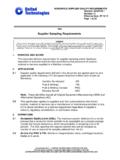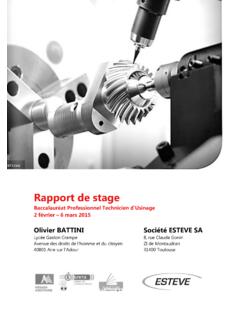Transcription of AEROSPACE SUPPLIER QUALITY REQUIREMENTS …
1 _____ Unpublished Work - UNITED TECHNOLOGIES CORPORATION 2011 ECCN: EAR 99 COPIES PRINTED FROM THE ON-LINE SYSTEM ARE CONSIDERED UNCONTROLLED AEROSPACE SUPPLIER QUALITY REQUIREMENTS Number: Revision: 2 Effective Date: 02/15/2011 Page 1 of 7 1. PURPOSE & SCOPE This specification defines REQUIREMENTS for Foreign Object Damage/Debris Prevention, Handling, Storage, Packaging, Preservation and Delivery of product, material, or services supplied to a UTC member company. It supplements but does not replace other UTC Business Entity REQUIREMENTS . 2. APPLICATION SUPPLIER QUALITY REQUIREMENTS are defined and agreed upon by the following business entities as members of the ASQR Common Specification Team herein referred to as member.
2 Aftermarket Operations AO Hamilton Sundstrand HS Pratt & Whitney PW Pratt & Whitney Canada PWC Sikorsky Aircraft SAC This specification applies to suppliers and their subcontractors who furnish product, material, or services (as a manufacturer or maintenance provider) to any of the above members as a contract requirement regardless of the SUPPLIER s industry, regulatory accreditation, or certification status. 3 DEFINITIONS Foreign Object Damage (FOD): Any damage attributed to a foreign object that can be expressed in physical or economic terms which may or may not degrade the product s required safety and/or performance characteristics. Foreign Object (FO): A substance or article alien to the product that could potentially cause FOD.
3 Unrestricted Hardware: Low value, high usage material, issued in bulk quantities and excluded from processing in a Materials REQUIREMENTS Planning (MRP) system. 5S: A method for improving workplace organization using visual controls ( , Sort, Straighten, Shine, Standardize, Sustain) resulting in a positive impact on FOD prevention, productivity and Environmental Health and Safety (EH&S). WARNING This document is the property of United Technologies Corporation (UTC). You may not possess, use, copy or disclose this document or any information in it, for any purpose, including without limitation to design, manufacture, or repair parts, or obtain FAA or other government approval to do so, without UTC s express written permission.
4 Neither receipt nor possession of this document alone, from any source, constitutes such permission. Possession, use, copying or disclosure by anyone without UTC s express written permission is not authorized and may result in criminal and/or civil liability. TITLE Foreign Object Damage/Debris Prevention, Handling, Storage, Packaging, Preservation and Delivery _____ Unpublished Work - UNITED TECHNOLOGIES CORPORATION 2011 ECCN: EAR 99 COPIES PRINTED FROM THE ON-LINE SYSTEM ARE CONSIDERED UNCONTROLLED AEROSPACE SUPPLIER QUALITY REQUIREMENTS Number: Revision: 2 Effective Date: 02/15/2011 Page 2 of 7 4. REQUIREMENTS FOD Prevention: The UTC REQUIREMENTS for FOD prevention are based on the National AEROSPACE Standard (NAS) 412, Foreign Object Damage/Foreign Object Debris Prevention, which establishes a baseline FOD prevention policy/procedure.
5 NAS 412 supports the QUALITY management system standard, AS/EN/JISQ 9100/9110/9120 which requires suppliers carry out a program for the prevention, detection, and removal of foreign objects from its products. FOD Prevention Program attributes are implemented at different levels of complexity based on risk/sensitivity of the product/services provided by any source. Suppliers shall implement a FOD Prevention Program having the suitable level of FOD prevention for their individual products/services. Note: The IAQG Supply Chain Management Handbook (SCMH) provides assessment tools, descriptions, and training material for FOD Program control attributes. The minimum REQUIREMENTS of a FOD Prevention Program for all product/service suppliers shall include: a.
6 A FOD training program shall be in place to increase employee awareness on causes and effects of FOD, promote active involvement through specific techniques and emphasize good work habits through work discipline. FOD training is required for all employees and contractors (internal and external) as applicable and shall be on going, ( , initial and periodic) to maintain employee awareness. Training shall include (but is not limited to) the following topics: Causes and effects of FOD Protection of product General housekeeping program and formal 5-S practices Clean as you go principles Tool control/accountability Unrestricted hardware control/accountability Consumable control/accountability _____ Unpublished Work - UNITED TECHNOLOGIES CORPORATION 2011 ECCN: EAR 99 COPIES PRINTED FROM THE ON-LINE SYSTEM ARE CONSIDERED UNCONTROLLED AEROSPACE SUPPLIER QUALITY REQUIREMENTS Number: Revision: 2 Effective Date: 02/15/2011 Page 3 of 7 b.
7 A documented procedure for material handling and part protection to eliminate potential FO/FOD and handling hazards that includes: Risk identification for sensitive parts, assemblies, surfaces, areas, etc. Risk identification related to packaging, handling, shipping and storage processes. Evaluation and controls for risk mitigation specific to cleaning, protection, and care processes. Defined process sequencing that allows for proper contamination prevention, cleaning, and detection on parts and containers at appropriate process points. Defined methods to protect parts where contact with other elements may be detrimental to the part ( , columbium, titanium, magnesium, etc.). c. A general housekeeping program and formal 5-S practices that includes: Area cleaning in accordance with 5-S principals ( , assembly, test, manufacturing, warehouse, and operational support areas).
8 Periodic cleaning/sweeping floors, work-surfaces and any other pertinent surfaces. Maintaining critical process areas free of open food and beverages. Areas having clear signage indicating REQUIREMENTS . d. A FOD reporting and investigation process shall be in place and define how to: Report and investigate FOD occurrences and include the use of common root-cause analysis tools as part of the record. Advise personnel of how to react in the event of a FOD incident, ( do not disturb evidence, cease operation, immediately notify supervision, begin investigation, etc.). Ensure effectiveness of corrective/preventive actions taken to preclude recurrence. Additional FOD Program REQUIREMENTS may be mandated by the UTC member depending on the FOD risk criticality of product, ( product / commodity type, manufacturing, assembly, and repair processes involved, etc.)
9 Suppliers with design control or repair development capability shall ensure the design applies considerations for FOD prevention, resistance to damage, and that designs are not conducive to debris entrapment to any extent possible. Methods are to include documentation and implementation of a process that reflects emphasis on the reduction of risk and potential elimination of FOD hazards as basic design criteria. _____ Unpublished Work - UNITED TECHNOLOGIES CORPORATION 2011 ECCN: EAR 99 COPIES PRINTED FROM THE ON-LINE SYSTEM ARE CONSIDERED UNCONTROLLED AEROSPACE SUPPLIER QUALITY REQUIREMENTS Number: Revision: 2 Effective Date: 02/15/2011 Page 4 of 7 Product designs or repair instructions shall reflect adequate consideration to: a.
10 Identify and eliminate FO entrapment areas. b. Identify and seal areas through which FO can migrate. c. Utilize adequate connectors, filtering devices, and protective covers over critical mechanical, electrical, hydraulic, and pneumatic components to prevent FO entry. d. Install special access panels, ports, etc., for inspection and removal of FO that could potentially cause damage. e. Install devices to divert migrating FO from critical mechanisms/components to special access areas for removal. f. Utilize fasteners with positive locking mechanisms in areas where high vibration levels are expected, or where separation of the fastened item could result in potential damage. g. Utilize blind fasteners in critical areas ( , fuel cells) that are not prone to leaving debris upon extraction.













